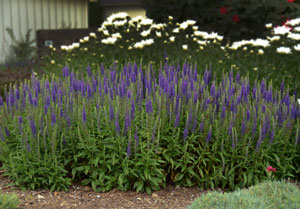12/27/2012
There’s a Little Magic in Hocus Pocus
Jeremy Windemuller
Prized for its showy blossoms over an extended period and its healthy, disease-resistant foliage, Veronica Hocus Pocus is favored by growers for its long shelf life and impulse appeal. Long wands of vivid violet-purple flowers stand at attention above the low-growing, bright green foliage, which remains attractive all season. It’s a strong grower with a large root system, finishing easily for growers and retail sales.
Potting & timing When growing Hocus Pocus from a 72-ct plug, plants potted up in a trade gallon should finish in eight to 10 weeks. When starting from a #1 grade bare root, plants potted up in a premium 1-gal. pot should finish in six to eight weeks or in a 2-gal. pot in 10 to 12 weeks. Use a porous, well-drained, peat/bark soil mix with a pH of 5.5 to 6.2.
C ultural recommendations
ultural recommendations
•
Fertility
Hocus Pocus is a moderate feeder. Apply a controlled-release fertilizer at 1 lb. nitrogen per cubic yard of growing media. If using a constant liquid feed with every irrigation, the recommended rate is 75 to 100 ppm nitrogen. Alternately, plants can be fed with 125 to 175 ppm liquid feed with every third irrigation. The EC rate using the pour-through method is 1.5 to 2.0.
•
Moisture
Hocus Pocus generally prefers moderate to moist soil. Be sure to water the plants all the way through and then allow them to dry slightly between irrigations to encourage strong root growth. Overly wet conditions can lead to crown and root rot. If using overhead watering, irrigate in the morning so the foliage is dry by evening.
•
Lighting
Hocus Pocus benefits from high-light intensities. Long days of at least 16 hours are required for flower production. If growing in late winter or early spring, supplemental lighting may be required to avoid stretching and to produce the best-looking crop.
•
Temperature
When plants are actively growing, a constant air temperature of 65 to 72F (18 to 22C) and warm soil temperatures will encourage root growth. Cooler temperatures will result in slower root growth. When plants are rooted out, a holding temperature of 40 to 50F (4 to 10C) will keep them neatly compact, preventing stretching in the pots.
•
Pests & diseases
At time of transplant, apply a broad spectrum fungicide drench on both bare root and plug material to prevent root and crown rot. Powdery and downy mildew can be problematic on veronica if grown under cool, damp conditions and if the foliage retains moisture. To prevent these diseases, provide good air circulation and space plants properly. Scout regularly for aphids and thrips, treating as necessary.
Finishing tips
•
Pinching & PGRs
When planted from bare root, Hocus Pocus doesn’t need pinching since the plants are already well-branched. When starting from 72-ct plugs, one soft pinch is recommended two to three weeks after planting to encourage branching. Deadheading will improve the plants’ appearance, but be careful not to remove the secondary flower spikes when deadheading the central spike.
We recommend rooting out and bulking up Hocus Pocus under 65 to 72F (18 to 22C) constant temperatures and then gradually cooling them down to 40 to 50F (4 to 10C) once established. Maintain high-light intensities throughout the growing process. Using this method, plants shouldn’t stretch and, therefore, shouldn’t require any PGRs. If you wish to use PGRs, northern U.S. spray rates are 2,500 ppm of B-Nine or 5 ppm of Sumagic. Rates may be higher in the southern U.S.
•
Forcing
Hocus Pocus is a cold obligate perennial. It will not flower if it’s not vernalized properly. If you receive your liners in late winter or early spring, they should already have been vernalized by your supplier. If receiving them in summer or fall, you will need to vernalize them for nine weeks in order to have flowers. Once vernalized, they should bloom in six to eight weeks under 65 to 72F (18 to 22C) constant temperatures.
GT
Veronica Hocus Pocus PPAF is a Proven Winners Perennial. A branded container is required for this plant.
Jeremy Windemuller is a grower and trial manager for Walters Gardens, Inc. in Zeeland, Michigan